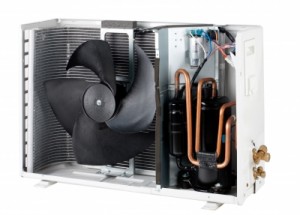What Is A Heat Exchanger?
A heat exchanger is a device which transfers, or exchanges, heat from one thing to another. In reference to a furnace, or an HVAC system, it has a dual purpose. It keeps any exhaust from entering the living space of your home while allowing the heat from your furnace to be distributed throughout your house.
A tube sends the exhaust one way and the warmed air another. When it begins leaking, it can supply the inside of your house with carbon monoxide, or CO, which is a poisonous gas. Not much creates an unsafe condition or lasting ill effects. When a leak is detected, the heat exchanger should be replaced, not fixed. They are made of metal and will always fail at some point or other, usually due to metal fatigue. When heated, metal expands. When it cools, it compresses. Eventually, the metal will form cracks and open.
NOTE: carbon monoxide is the bad stuff, carbon dioxide is what we exhale.
Checking The Heat Exchanger
The heat exchanger must be inspected regularly. This is done visually and with an infrared video inspection system. A breach can be detected when light can be seen through a crack or hole. Simply testing whether or not carbon monoxide is present will not tell you whether or not the exchanger is leaking, as the furnace produces carbon monoxide when it runs normally. If a technician checks your furnace and happens upon a leak, your furnace will be “red tagged” and shut down until the exchanger is replaced, regardless of the outside temperature. Therefore, you want to be careful about your timing to ask for professional advice. Since the technician is bound by law to shut down your furnace, there is no debating about the matter. So, before you call a technician in the dead of winter, take the time to look yourself. Sadly, there are those companies looking for a quick (and often dishonest) buck. So if you are told your exchanger is not working, it is always a good idea to get a second, and sometimes third, opinion.
Because each test in and of itself is not a sure thing, it is best to perform at least two, and preferably more, of the tests listed. These you can perform yourself:
Visual Test: This is a tricky test, as you might not be able to see the entire exchanger. The evaporator coil might keep you from seeing a portion of it, or other obstructions. If you choose to visually inspect, be sure to have a really bright, preferably flexible flashlight and mirrors that mechanics or dentists use so you can see the opposite side.
Discoloration: If you see a change in color along the exchanger, take a really good look at it. This may be a symptom of either that either soot or heat has regularly escaped, causing the discoloration.
Water Damage: Should the furnace be exposed to water damage, there is a good chance the exchanger will be damaged as well. Since the hottest air is normally found in the exchanger, a sudden temperature drop from the water entering the exchanger can create a crack.
Flame Test: When the blower on the furnace is running, does the flame dance erratically or change color? This is a sign the heat exchanger is leaking.
Flue Test: If a technician were to tell you that your exchanger is leaking solely on a flue gas testing, get another opinion. The test measures a change in the flue gas between when the furnace is or is not heating. There are many reasons the gases can be different. On the flipside, there could actually be a leak in the heat exchanger that the test does not even catch. It is best not to rely on this test.
Scent Test: Since the carbon monoxide is odorless, you cannot count on its smell to be detected throughout your house. However, you can add a few drops peppermint, or some other strong scent not already present, and check to see if any rooms smell of it. If so, don’t hesitate to shut down the furnace immediately and replace the exchanger. If this would be an impossible task financially, then at least invest in carbon monoxide detectors in every room of the house. In all seriousness, someone could die and you really don’t want to expose a family member just to stave off a repair until is it convenient.
Water Test: There are some folks who stand by notion that the exchanger can be dismantled and filled with water. If it leaks water, then it leaks carbon monoxide. However, it is best to avoid this particular test. There is no guarantee that the exchanger will work after the test!
Conclusion
A cracked heat exchanger does not necessarily mean that everyone in the household is definitely going to die in the next few minutes. But it does mean you are on your way to a serious problem, even if you can get away with it short term. In the short term, get at least one carbon monoxide detector per room. Put the detectors at least five feet off the ground, as carbon monoxide is lighter than the normal air mixture. Then, begin immediately to build the piggy bank of saved money for the next heat exchanger and buy it soon.




 Auto insurance quote
Auto insurance quote Get a Business Loan
Get a Business Loan